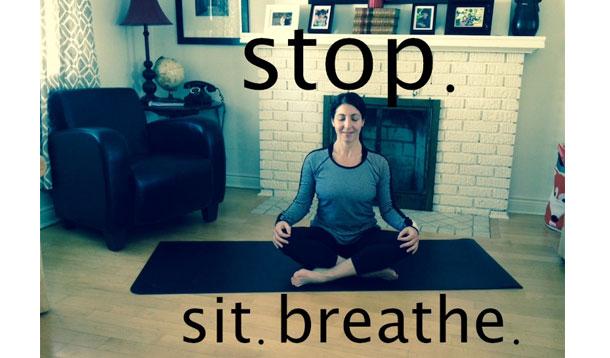
There are many profound and beautiful words to describe motherhood, but peaceful is not one of them. Our household is full of noise. From cries to laughter, from singing to shouting, from music to meltdowns, and from whispers to wails. It is full. Of love. And of noise.
On top of this, there is the noise in my own head. The to-do lists to finish, the meal-planning, the work deadlines, and the other random thoughts that swirl around in there. Some days it’s like a crowd of rowdy teenagers have taken up shop in my mind. So one of the things I crave on a daily basis is silence. Not just quiet, but peace. And the best way for me to find this is through my meditation practice.
When I talk to people about meditation I often hear one of two responses: “I’ve always wanted to meditate but don’t know where to start,” or, “I could never meditate because I can’t sit still for 30 seconds.”
I’ll address the first statement in this post, with suggestions on how to start meditating. I’ll address the second statement in my next post, I promise, so don’t give up hope if you’re the, “I-can’t-sit-still,” type!”
So, how do you start meditating?
Here’s the lowdown: all you need to do to start meditating is simply start a meditation practice.
Stop. Sit. Breathe. Repeat.
Sounds simple, right? But it’s the simplicity of it that can make meditation so hard for so many people.
There are books, apps, videos, podcasts, studio classes and many online resources that can help you. But the important thing is to commit to trying it out. And to STICK with it.
Start with five minutes of meditation a day and I guarantee that, once it becomes a habit, you’ll find that five minutes isn’t enough. There are many types of meditation, and some people prefer one technique over another. Here are the three techniques that are most popular with my clients:
The focus is simply on your breathing. Close your eyes and notice the breath as it comes in and out of your body. Allow your breathing to deepen, and observe the subtle movements of the body as you inhale and exhale. Your mind will begin to wander (it’s completely natural), so when you notice this, simply bring your attention back to your breathing. Focus on the natural rhythm of your inhalation and exhalation.
In a mantra meditation you focus on a statement, a phrase or a word. It can be a Sanskrit word like, “om,” a phrase of your own that inspires you, or a statement or affirmation of something you’re trying to incorporate into your life. I have repeated the words, “I am calm,” and, “I am patient,” during many a meditation because calm and patience are what I needed at the time. Another simple phrase to repeat is, “let go.” Begin by focusing on the breath. As you inhale, repeat the word, “let,” in your mind. As you exhale, repeat the word, “go." If your mind starts to wander, you can focus back in on the word(s). To listen to a guided mini meditation on letting go, click here.
The focus of the meditation can be an object, a mental image of a place or a physical picture. You could stare at the flame of a candle and maintain your focus on the flame. You could hold a rock or special object in your hand and concentrate on that. Or you could close your eyes and focus your thoughts on a location or place or object that makes you happy. For example, there is a dock at my husband’s family cottage where I love to write and do early morning yoga. I will often conjure the image of that place in my mind’s eye and focus on the calm and contentment I associate with the location.
Your mind will never be completely quiet. Meditation will teach you to observe thoughts and not attach weight to them. The image that I like to use with clients is to consider thoughts like clouds passing through the sky. They will never go away. But we can learn to acknowledge these thoughts, and let them pass through our minds without making judgments about them.
You can meditate anywhere. You don’t need to be seated on a special cushion with a statue of a Hindu god in front of you. Finding a quiet place in your home is ideal, but I have meditated in a car (parked, of course!), on the subway, on a park bench, on an airplane.
You don’t “get good” at meditation. There are days when I find meditating just as hard as the first few times I tried it. Then there are other days when my mind becomes calm and clear with seeming ease. What is most important is the act of continuing to meditate. This is why it is called a meditation practice.
Stay tuned for the next instalment when I tackle how to meditate when you can't sit still. In the meantime, if you're struggling to wake up before your morning coffee, try starting your day with these yoga tips. Or find out how to do yoga without wrecking your body.